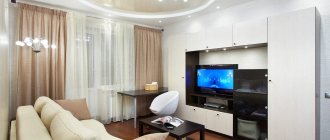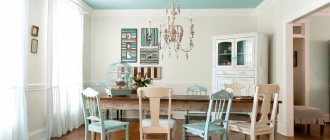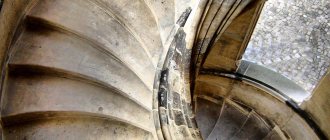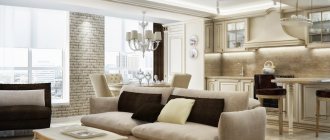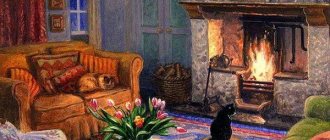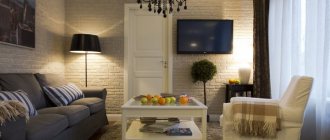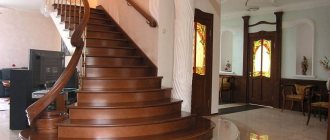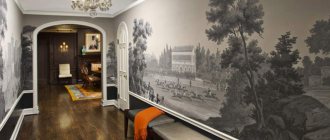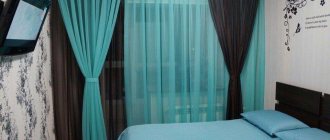An experienced designer creates an interior united by a single artistic meaning, harmoniously combining art objects with decor and furniture. The synthesis of painting, architecture and sculpture is what distinguishes an ordinary apartment from a designer’s plan.
Mid-century modern: what is it and how to “assemble” it
The past and the future are harmoniously combined in this interior style from the middle of the last century. How does he manage to look modern in 2020? Let's take a closer look at the mid-century and see how to recreate this setting based on the Russian interior.
How to learn to use techniques to create harmonious and expressive interiors? What is a synthesis of arts in a modern interior, and how to create it? We will tell you about the main principles of interior design in this article.
First, let’s define professional terminology, the interpretation is given by the Encyclopedia of Cultural Studies:
“Synthesis of arts is a combination of different types of art that has a multifaceted aesthetic impact. The unity of the components of the synthesis of arts is determined by the unity of the ideological and artistic concept.”
Scale and proportions
These are two of the most insidious tools that can easily be used incorrectly. Who hasn’t seen windows that are too large or a room that is too narrow, perhaps columns that are too small? Any designer should have a natural sense of these two standards of ideal structure, which any self-respecting master of the art of construction strives to understand.
Work by Mahoney Architects & Interiors
Mirrors
They will instantly transform the space - increase the amount of natural light and create a feeling of spaciousness in the room. They are also good as decorative accents: with their help you can decorate an empty wall above a chest of drawers or dressing tables, complement the fireplace area in the living room, or become the only decoration in a minimalist hallway.
Design: Natalya Moshnina, Irina Drotenko
Design: Natalya Moshnina, Irina Drotenko
Design: Varvara Shabelnikova
Design: Varvara Shabelnikova
Lobbies
Initially, this type of room was invented as a transitional space from the street to the comfort of home, protecting the holy monastery from uninvited guests, dirt, dust and cold. And gradually they began to acquire their own unique character, which was transmitted to all rooms.
Of course, many architects associate lobbies with relics of the past, but even today you can find their modern interpretation, for example, as in this photo.
Creation of the studio LDa Architecture & Interiors
Multi-figure composition in painting
It is interesting to know how famous artists of the past and masters of the present dealt with the problems associated with this artistic movement.
You may be interested in:Metal paintings: description, technique, photo
The Sistine Chapel is Michelangelo's greatest creation. To paint it, he used various biblical scenes that tell about the creation of the world and the appearance of people on earth, etc. With the help of scale - the large size of the main figures - the painter achieved the effect of special expressiveness of key scenes.
Michelangelo's human figures are distinguished by their vivid expression, each gesture has its own deep meaning. At the same time, it is easy to find and read. For example, a person with his head in his hands conveys thoughtfulness and detachment. The image of a hunched figure expresses despondency and sorrow.
The multi-figure composition symbolizes in poses and gestures not only the expressiveness of the action, but also reveals its content.
It’s interesting that often some gesture conveys the author’s intention and plays his role. Drawing the viewer's attention to some phenomenon with the help of an outstretched arm helps expand the boundaries of the plot and indicates what is happening beyond its boundaries.
You might be interested in:Alexey Merinov, artist and cartoonist
No less important in this form of art is the gaze, what it is directed at. Thus, you can link individual figures or combine them into a group, separating one character from all others, thereby highlighting it.
In this direction of art, one-figure, two-figure and multi-figure compositions are distinguished.
Decorative railings
Building codes dictate strict requirements regarding the height, location and load that these home “rails” must withstand. However, the imagination of designers is so limitless that, finding loopholes in the standards, they transform modern interiors with the help of railings.
Work by architects Smith & Vansant PC
Zoning with partitions and screens
The method is perfect for:
- Bedroom-living room
- Bedrooms and workplaces
- Kitchen-living room
- Dividing the nursery into 2 parts
The variety of shapes and types allows the partitions to fit into any interior style. They take up minimal space, so they can be installed in a large loft or in a compact studio.
The interior uses 2 types of partitions - full and partial zoning.
Partitions of incomplete zoning
These are all kinds of decorative partitions - carved, slatted, wicker, stained glass, as well as screens. They not only separate, but also serve as interior decoration - they can be made as a bright accent or an unobtrusive finishing touch. Particularly noteworthy are designs that allow you to transform space in a matter of seconds.
Full zoning partitions
Separate the area from the floor to the stream. These include sliding and hinged partitions made of glass, wood and metal and sliding doors. Classic option: highlighting a bed area in the room using transparent glass partitions, complemented by curtains. An equally popular way is to separate the kitchen from the living room.
This solves two problems at once:
- a separate zone is created with its own design and mood;
- the rest of the room is protected from smoke and odors.
Daylight
Many designers strive to ensure that every room is immersed in sunlight. And it doesn’t matter where the windows will be: traditionally in the walls at eye level or above the head, perhaps even that they will be in the roof itself, in any case, natural light will enliven even the darkest room.
It is especially interesting to observe how the interior changes its mood depending on the time of year or day. In every period of time he is unique and charming.
Design by architect Aleck Wilson
Add a story
Integrating antique items and heirloom furniture into the interior will help add nobility. It is important at the planning stage to allocate a dominant place for valuables and combine them harmoniously with modern furniture and finishing materials. Combining the incongruous—this is the skill of a designer.
Terence Conran: the designer who reinvented convenience
“Good design is 98% common sense and 2% aesthetics”
Large corner windows
The traditional way of building a house was to build walls connected by a foundation and a roof. Then windows and doors were cut into them. But everything began to change in the 19th century, when architects created the so-called cornerless room.
With the help of modern technologies, large areas are cut out of the walls to insert large glass, creating chic panoramic windows, for example, as in this photo.
Project by Dick Clark + Associates
Interior space
Creating an interior in a painting has certain difficulties. Even Giotto di Bondone, an Italian artist and founder of the Proto-Renaissance, painted a multi-figure composition in an interior, which was often located in an open space. The painter added external architectural forms to the image: columns, pediments and roofs. Sometimes several interiors were depicted on one canvas.
At that time, this technique in the artist’s work was perceived not as a closed space, but as an architectural design that separates events and makes them deeper in content.
The evolution of the interpretation of multi-figure composition in interior painting is most successfully outlined in the works of the Proto-Renaissance period. This is a period in the Renaissance that lasted from the second half of the 13th century and into the 14th century. Attention in them is mainly focused on developing the rules of direct perspective, which is easiest to show using examples of the interior, while the problem of closure remained open. The term “interiorism” has always been equivalent to a deviation from strict norms in a direct perspective and has had special figurative spatial tasks.
The enclosure and size of the interior began to be most deeply understood as soon as art reached the appropriate stage of development. Techniques have emerged to create the impression that the viewer is present in the interior.
An essential component of the image is the closedness of the frame, its size and the feeling of the presence of the audience themselves in the picture.
Competent design
Gone are the days when people suffered from unbearable heat, constant drafts and cold. Today we have solved this problem with the help of new designs. However, this circumstance has a second side to the coin.
If you overdo it or use this material incorrectly during construction, the house will turn into a vacuum box with no hope of fresh air. Therefore, knowledge of construction fundamentals among architects is valued above all else.
Scheme from Bud Dietrich, AIA
Static group portrait
For many centuries this type of painting occupied the most important place. Many artists made money by painting portraits. Indeed, in times when there was no photography, painting a portrait was the only opportunity to capture an important moment for a long memory, to perpetuate an image of yourself and your relatives. While posing, each of the participants tried to look attractive and rich.
Lots of light
Designers know how important light is in an interior, so they always think through several lighting scenarios for each room. Along with the main one, the local one is very important: sconces and table lamps will create an intimate atmosphere in the bedroom and children’s room, and in the living room you can’t do without a floor lamp with warm light.
Design: Home Emotions Bureau
Design: Home Emotions Bureau
Design: Tatyana Ivanova
Design: Tatyana Ivanova
